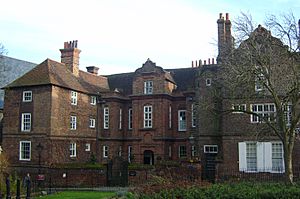Restoration House facts for kids
Quick facts for kids Restoration House |
|
|---|---|

Restoration House from The Vines
|
|
| Type | House |
| Etymology | Visit of King Charles II on the eve of his restoration |
| Location | Rochester, Kent |
| OS grid reference | TQ 74363 68213 |
| Earliest phase | 1454 |
| Restored by | Rod Hull and subsequent owners |
| Current use | Home |
| Website | https://www.restorationhouse.co.uk/ |
|
Listed Building – Grade I
|
|
| Official name: Restoration House including wall and gate piers attached to front | |
| Designated | 24 October 1950 |
| Reference no. | 1185341 |
|
Listed Building – Grade II
|
|
| Official name: Remains of summer house in garden 25 metres east of Restoration House | |
| Designated | 2 December 1991 |
| Reference no. | 1086519 |
|
Listed Building – Grade II
|
|
| Official name: Flint and diapered brick wall at rear of Nos 1 and 3, East Row | |
| Designated | 23 January 2008 |
| Reference no. | 1392369 |
| Lua error in Module:Location_map at line 420: attempt to index field 'wikibase' (a nil value). | |
Restoration House is a beautiful old mansion in Rochester, Kent, England. It's called "Restoration House" because King Charles II stayed there in 1660. This was just before he became king again, a time known as the Restoration.
King Charles arrived in Rochester on May 28, 1660. He spent the night at the house, which belonged to Colonel Gibbon. The next day, May 29, he traveled to London and was officially made king on his 30th birthday. Even though Colonel Gibbon lived there, the house was actually owned by Sir Francis Clerke.
Today, Restoration House is a private home. However, its house and gardens are open to visitors during the summer months. It is also a protected building, known as a Grade I listed building.
History of Restoration House
Restoration House wasn't always one big building. It started as two separate medieval buildings, built around 1454 and between 1502 and 1522. In the mid-1600s, a third building was added between them. This joined the two older parts to create the larger house we see today.
The first owner of the completed house was Henry Clerke. He was a lawyer and a Member of Parliament for Rochester. Around 1670, Henry Clerke made more changes to the house. He updated the front entrance and added a grand staircase inside.
Later, the house was bought by William Bockenham. In the late 1800s, Stephen T. Aveling owned it. He even wrote a history of the house.
In 1986, the famous English entertainer Rod Hull bought Restoration House. He wanted to save it from being turned into a car park. He spent a lot of money making sure the house was restored and looked its best. The house was later sold in 1994.
The current owners have been working on the house for over ten years. They have found old decorations from the 1600s. These discoveries show the popular styles of that time, which were often influenced by European fashions.
Charles Dickens and Satis House
The famous writer Charles Dickens lived nearby in Rochester. His biographer, John Forster, said that Dickens used Restoration House as inspiration. It became the model for Miss Havisham's Satis House in his well-known novel, Great Expectations.
The name "Satis House" actually comes from another house in Rochester. That house was where Sir Richard Watts, a Rochester Member of Parliament, once hosted Queen Elizabeth I. Today, that original Satis House is an office for King's School, Rochester.

